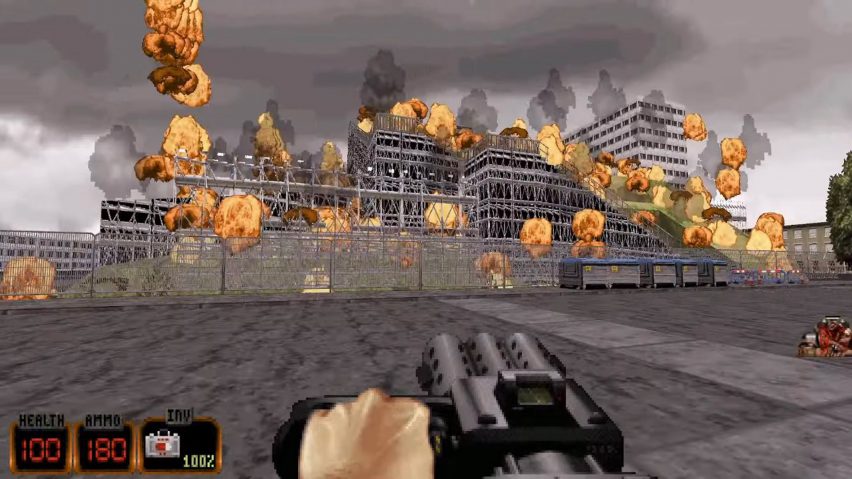Video game designer Dan Douglas has recreated MVRDV's Marble Arch Mound within a modified version of 1990s video game Duke Nukem so that disappointed visitors can blow it up.
Douglas added the Marble Arch Mound to his Duke Smoochem 3D modification of the original game, which he is creating to be an absurd reflection of modern-day Britain.
He chose to add the ill-fated Marble Arch Mound, which opened incomplete and over budget, as he believes it demonstrates a moment of recent absurdity.
"To me, the Mound represents a total failure of concept, planning, execution and aesthetics, a literal monument to ugly unnecessity," Douglas told Dezeen.
"Additionally, the structure itself resembled a simplistic low-polygon render so I thought that using a decades-old video game engine to depict it was fitting."
demolishing the Marble Arch Mound, in Duke Nukem 3D pic.twitter.com/Kcr65e1M0z
— Dan Douglas (@dandouglas) July 31, 2022
In the game, the installation can be blown up
Erected by Westminster City Council in the summer of 2021 to draw people back to the Oxford Street shopping district following coronavirus, the artificial hill was designed by Dutch studio MVRDV.
The installation was widely criticised for opening early and being incomplete. After being ridiculed by critics it temporarily closed before reopening as a free attraction.
Architect MVRDV blamed Westminster City Council's "loveless execution of our designs" for the fiasco, which led to the council's leader resigning.
Douglas hopes that blowing up the structure will be fun for those disappointed by the attraction and the amount of public funds used to realise it.
"I hope it's a satisfying or perhaps even cathartic moment for disappointed visitors, or indeed anyone sick of seeing millions thrown at ill-advised, badly-run projects," said Douglas.
"Blowing up things in video games is always good fun, and blowing up something not only recognizable but also widely loathed will hopefully be a hit with players," he continued.
"The Mound was doomed from the start, with its inevitable dismantlement costly and drawn-out. Duke Nukem's time-honoured approach is simply quicker and more efficient, potentially saving Westminster Council hundreds of thousands of pounds."
Douglas is building Duke Smoochem 3D as a modification of the popular 1990s first-person-shooter game Duke Nukem.
Once complete Douglas will release the game, which will be available on Windows to people with a registered version of the 1996 version of the game Duke Nukem 3D.
The project began as a satirical comment on UK health secretary Matt Hancock being caught on CCTV kissing his aide. However, the project has been extended to create a world of quirky British moments and includes the tent from British TV show Great British Bake Off, a pub from UK chain Wetherspoons and the bus used to promote the benefits of Brexit.
"The mod began as a quick gag to recreate CCTV capturing Matt Hancock's affair using Duke Nukem 3D's security camera feature, and it kind of snowballed from there to encompass as many British absurdities as I can cram in," Douglas said.
Douglas is building the game using a Mapster32 – an upgraded version of the Build editor which came with the game in 1996. According to the designer, the shape of the installation meant it was relatively easy to digitally recreate.
"It's very hands-on, no automation or dynamic lights or anything like that – every textured surface has be shaded by hand, every static shadow drawn in manually," he explained.
"Marble Arch Mound was fairly easy to create, but harder to destroy, with the effect encompassing dozens of time-delay triggers and hundreds of explosion sprites primed to go off in sequence," he continued.
"I used a few reference photos of the site and built an approximation rather than attempting a strict recreation – it's still a work-in-progress, and I'm hoping I can find time to add more detail and refine the collapsing effect."
Douglas hopes to release the game in 2024. Research studio You + Pea recently released a Videogame Atlas, which includes panoramic maps, playful diagrams and layered illustrations, to highlight the use of architecture in video games.

